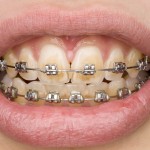
The development of early, but reversible, carious lesions or demineralised white lesions (DWLs) is one adverse effect of fixed appliance orthodontic treatment. The prevalence has been reported to be as high 70%, and although the majority are minor and fade with time as they resolve about 10% cavity and may require filings. The main aim of this review was to evaluate the effects of fluoride in reducing the incidence of demineralised white lesions (DWLs) on the teeth during orthodontic treatment.
Searches were conducted in the Cochrane Oral Health Group’s Trials Register; the Cochrane Central Register of Controlled Trials (CENTRAL); Medline and Embase databases. The bibliographies were checked for additional studies. Randomised controlled trials (RCTs) using any topical fluoride delivery method to prevent DWL formation during orthodontic treatment with fixed braces were included. Assessment and analysis of the identified studies followed the usual Cochrane methodology.
- 3 studies (458 patients) were included, One at low risk of bias, one at high risk and one where the risk was unclear.
- One study of fluoride varnish (0.1% fluoride) applied every six weeks (253 patients, low risk of bias), found an almost 70% reduction in DWLs (risk ratio (RR) 0.31, 95% confidence interval (CI) 0.21 to 0.44, P value < 0.001).
- This finding is considered to provide moderate-quality evidence as it has not yet been replicated by further studies in orthodontic participants.
- One study (97 patients, unclear risk of bias) compared amine fluoride and stannous fluoride toothpaste/mouthrinse combination and a sodium fluoride toothpaste/mouthrinse and found no difference for the outcomes of white spot index, visible plaque index and gingival bleeding index.
- One small study (37 participants) compared the use of an intraoral fluoride-releasing glass bead device attached to the brace versus a daily fluoride mouthrinse. The study was assessed at high risk of bias because a substantial number of participants were lost to follow- up, and compliance with use of the mouthrinse was not measured.
- Neither secondary outcomes of this review nor adverse effects of interventions were reported in any of the included studies.
The authors concluded:-
This review found some moderate evidence that fluoride varnish applied every six weeks at the time of orthodontic review during treatment is effective, but this finding is based on a single study. Further adequately powered, double-blind, randomised controlled trials are required to determine the best means of preventing DWLs in patients undergoing orthodontic treatment and the most accurate means of assessing compliance with treatment and possible adverse effects. Future studies should follow up participants beyond the end of orthodontic treatment to determine the effect of DWLs on participant satisfaction with treatment.
Comment
In this update several studies included in the previous version of this review have been excluded. This included 5 quasi-randomised trials, 5 split-mouth studies and 3 studies where outcomes were measured ex vivo on extracted teeth. As the authors note the focus on parallel group studies with the patient as the unit of randomisation helps remove the possibility of cross-contamination between experimental and control teeth in the same mouth, either between upper and lower arches or between sides of the mouth, which might lead to under-estimation of the effectiveness of any fluoride products. In addition to fluoride other approaches to reducing WSLs have been used ( Dental Elf – March & July 2013)
Links
Benson PE, Parkin N, Dyer F, Millett DT, Furness S, Germain P. Fluorides for the prevention of early tooth decay (demineralised white lesions) during fixed brace treatment. Cochrane Database of Systematic Reviews 2013, Issue 12. Art. No.: CD003809. DOI: 10.1002/14651858.CD003809.pub3.
Kevin O’Brien’s Orthodontic Blog :- Fluoride and orthodontic decalcification

[…] Dental Elf – 27th Jan- 2014 – Moderate evidence that fluoride varnish applied regularly duri… […]
[…] Dental Elf – 27th Jan 2014 – Moderate evidence that fluoride varnish applied regularly durin… […]